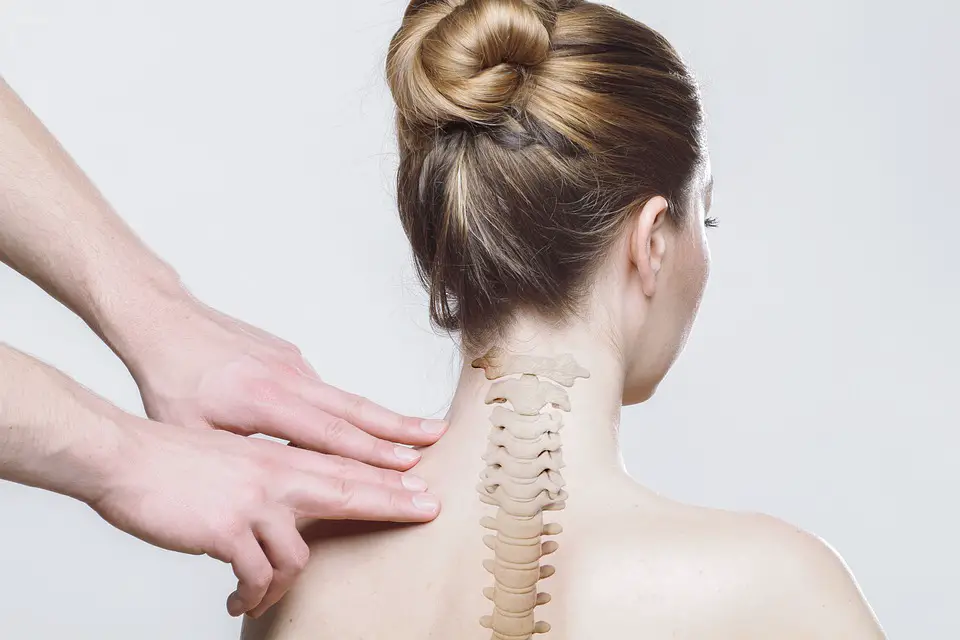Just like the lumbar canal, cervical spine may also be subject to shrinkage. This can lead to a conflict between the contents (spinal cord and upper limb nerves) and the containing who is constitutionally narrow.
If the disease continues to progress, irreversible neurological damage can set in and handicap the affected person.
Discover in this article everything there is to know about the narrow cervical canal.
Definition and anatomy of the cervical spine
The neck is the part of the body corresponding to the junction between the head and the trunk. Through it pass the afferent and efferent information of the nervous system, the cranio-cervicofacial and encephalic vascularization. Beyond its role as a transit zone, the neck, in particular the cervical spine, supports the head and gives it mobility.
It consists of 7 cervical vertebrae which are subdivided into two segments: the lower cervical spine de C3 to C7 and craniospinal hinge de C0 to C2.
Le narrow cervical canal current is a channel narrowing in which are the spinal cord and the nerves of the upper limbs (cervical spinal canal).
This reduction in caliber can occur at the level of the bones or at the level of the intervertebral discs. It can just as easily manifest itself on both structures at the same time.
Causes of narrow cervical canal
This is the more often by pathology linked to osteoarthritic degeneration (progressive age-related lesions) of the cervical spine, the canal of which contains the spinal cord. First, the intervertebral disc becomes dehydrated and loses height. This causes the formation of "parrot's beaks" called osteophytes, the thickening and calcification of the ligamentous structures as well as the sliding of certain vertebrae called " listhesis ". All these phenomena lead to a reduction in the spinal canal volume and a compression of the cervical cord, which will be responsible for disorders in the functioning of the latter.
In some people, the size of this channel is narrower due to the anatomy of the vertebrae. This is called a congenital cervical stenosis ou "constitutional".
other pathologies especially tumorous ou inflammatory can also be the cause of the reduction in the size of the canal with more or less serious consequences.
Symptoms of narrowing of the cervical canal
There’s plenty of narrow cervical canal symptoms can manifest in various forms. At first, it may remain asymptomatic for a long time before causing motor disorders (problem with balance, difficulty using the upper and lower limbs). In case of foraminal narrowing, the patient may suffer from radiculalgia. The latter indicates painful compression of a nerve root within the spine.
The early signs of a myelopathy (suffering from spinal cord) can be manifested by a slight balance disorder.
In later stages, a walking disorder associated with a sphincter disorder may appear.
Link between narrow cervical canal and fatigue
La fatigue is usually the symptom of another problem. The question to ask is "why am i tired »? There are many reasons for being tired and possible causes depending on the type of fatigue experienced.
Beware of the amalgam between “fatigue” and “asthenia”. Fatigue is an unpleasant feeling caused by excessive physical exertion or intense intellectual activity. It's a normal process. It is transient and reactive. On the other hand, asthenia is a pathological state which reflects a lack of both physical and moral strength (state of depression). She is not or little relieved by sleep or rest. The person feels an imbalance between what they have to accomplish and what they feel capable of doing.
Le narrow cervical canal causes several symptoms, including neck pain (pain in the neck), which is one of the most common symptoms. The embarrassment also associates a weakness and a muscular fatigability of the four members obliging the stop of the walk, after a few hundred meters.
The narrow cervical canal can also cause other symptoms such as fine motor disorders of the hands (can't close shirt buttons, can't write) or sphincter control disorders in more severe cases. severe…
So how does the narrow cervical canal relate to fatigue?
First, there is the stress and anxiety caused by the discovery of the disease which sets off often a general state of fatigue. When we are stressed, our body and our mind enter a state of tension, which causes fatigue.
Then there is the muscle fatigue which is often disabling. The simple activities such as preparing a meal, climbing stairs, cleaning, washing or dressing become real challenges. When we get up in the morning, we are already tired. We are so tired that we can no longer do anything.
Rest assured, fatigue does not affect everyone with a narrow cervical canal. However, the majority of sick people surveyed believe that fatigue affects their daily life as much, or even more than neck pain.
How is a narrow cervical canal diagnosed?
Several complementary examinations may be necessary in order to establish the diagnosis of cervical canal stenosis.
Cervical X-rays (front and side)
X-rays can be used to look for osteophytic beaks and a disorder of the cervical statics.
Right and left three-quarter radiographs allow the intervertebral foramina to be analyzed and to highlight possible osteoarthritic foraminal stenosis that could be responsible for radiculalgia.
Finally, dynamic X-rays (in flexion and in extension) of the cervical spine make it possible to look for any cervical instability.
Cervical X-rays are a good screening test, but do not allow visualization of neurological elements or possible herniated disc.
Cervical computed tomography (scanner)
Certainly less efficient than MRI for studying the spinal cord and nerve roots, but it provides very interesting information on the bone and therefore on what compresses the cord or the roots.
Cervical MRI
MRI is currently the examination of choice in the context of management of pathologies of the cervical spine. It makes it possible to appreciate the pathological rearrangements of the vertebral endplates adjacent to the disc which may be the cause of neck pain. She also shows signs of pain in the spinal cord (spinal hypersignal) and compression of a root in her foramen.
Treatment of this pathology of the cervical spine
Different treatment options are possible depending on the type, location and extent of compression. L'goal is decompress the spinal cord and nerves while providing stability to the spine.
Conservative treatment is usually prescribed as first-line therapy to alleviate painful symptoms. If conservative treatment fails or is not sufficient to relieve pain, surgical treatment may be considered.
Conservative treatment
Apart from emergency signs (motor deficit, signs of spinal cord compression, hyperalgesia), conservative treatment must be offered to the patient as first intention in order to reduce painful symptoms and avoid surgery.
Rest
Rest is the first step in treatment, especially for patients with work activities involving the carrying of heavy loads. The rest period can range from a few days to a few weeks. Ideally, rest should be relative, that is, the patient should continue with their activities as long as the pain is under control. Indeed, prolonged bed rest should be avoided because of the many risks of complications (sedentary lifestyle, muscle atrophy, stiffness, venous thrombosis, bedsores, etc.).
Les anti-inflammatoires
Non-steroidal anti-inflammatory drugs (NSAIDs) are often used first-line, with predominant efficacy on axial symptoms (spinal pain). If this is ineffective, corticosteroids can be offered to target the root edema.
Analgesics
In the absence of contraindications, level I and II analgesics (paracetamol, tramadol, etc.) may be offered to the patient. Level III analgesics are prescribed as a last resort (morphine).
Physiotherapy
Once imaging has been performed to clarify the diagnosis, and the major signs discarded, the cervical physiotherapy may be helpful in relieving symptoms and improving function.
In general, it combines manual techniques with therapeutic exercises aimed at relieving pain and strengthening cervical muscles.
For example, the physiotherapist can integrate cervical traction or an isometric strengthening of the cervical musculature. In addition, cervical massages for analgesic purposes as well as the application of heat to the posterior part of the neck can relieve the neck pain (often temporarily) of the patient.
Surgical treatment
Surgical treatment is only indicated in the event of persistent pain after 3 months of well-conducted medical treatment. However, in the event of motor deficit established for less than 72 hours (spinal cord compression) responsible for tetraparesis (partial loss of motor capacities of the four limbs) or cervico-brachialgia hyperalgesic, the surgical indication can be posed in urgency.
La narrow cervical canal surgery consists of increase the diameter of the channel to leave more room for the nerves and decompress them.
Decompression surgery
There are several types of decompression surgeries. The medical terms used to name these procedures are different depending on the procedure performed: laminectomy, discectomy ou corpectomy.
These operations consist of remove part of the vertebrae ou of ligaments, or prominent disk to relieve compression on the nerves.
The most common surgical technique used for spinal stenosis is a laminectomies (i.e. a blade is removed from the vertebra). This technique enlarges the spinal canal to decompress the spinal cord and relieve symptoms such as tingling and weakness typical of spinal stenosis.
In some cases, we just use a discectomy (i.e. one or more intervertebral discs are removed) or corpectomy (remove part of the vertebral body), if the compression is really severe.
Cervical arthrodesis (or vertebral fusion)
The release of the nervous structures induces in certain cases an instability requiring an associated gesture of stabilization which one calls cervical arthrodesis.
Cervical arthrodesis is traditionally used to treat degenerative pathologies of the spine. With bone grafts and instrumentation such as metal rods and screws, this surgical technique fuses two or more adjacent vertebrae. The goal is to stabilize la spine and ease the pain.
References
http://www.ch-larochelle.fr/sites/ch-larochelle/files/u9870/canal_cervical_etroit_ok.pdf


